| Article ID | Journal | Published Year | Pages | File Type |
|---|---|---|---|---|
| 5848517 | Chemico-Biological Interactions | 2011 | 9 Pages |
Abstract
2-Methyl-1,4-naphthoquinone (menadione or vitamin K3; EPO) and K3-2,3-epoxide (EPO1), but not vitamin K3-3-OH (EPO2), exhibited cytotoxicity that caused DNA fragmentation and chromatin condensation in U87 and C6 cells. EPO1 showed more-potent cytotoxicity than EPO, and the IC50 values of EPO and EPO1 in U87 cells were 37.5 and 15.7 μM, respectively. Activation of caspase 3 enzyme activity with cleavage of caspase 3 protein was detected in EPO1-treated U87 and C6 cells, and the addition of the caspase 3 peptidyl inhibitor, DEVD-FMK, reduced the cytotoxic effect of EPO1. An increase in the intracellular ROS level by EPO1 was observed in the DCHF-DA analysis, and EPO1-induced apoptosis and caspase 3 protein cleavage were prevented by adding the antioxidant, N-acetyl-cysteine (NAC), with decreased ROS production elicited by EPO1. Activation of ERK and JNK, but not p38, via phosphorylation induction was identified in EPO1- but not EPO- or EPO2-treated U87 and C6 cells, and this was blocked by adding NAC. However, the ERK inhibitor, PD98059, and the JNK inhibitor, SP600125, showed no effect on EPO1-induced cytotoxicity in either cell type. Our findings demonstrate that 2,3-epoxide substitution significantly potentiates the apoptotic effect of vitamin K3 via stimulating ROS production, which may be useful in the chemotherapy of glioblastoma cells.
Keywords
Related Topics
Life Sciences
Environmental Science
Health, Toxicology and Mutagenesis
Authors
Jender Wu, Chih-Chiang Chien, Liang-Yo Yang, Guan-Cheng Huang, Min-Chi Cheng, Che-Tong Lin, Shing-Chuan Shen, Yen-Chou Chen,
